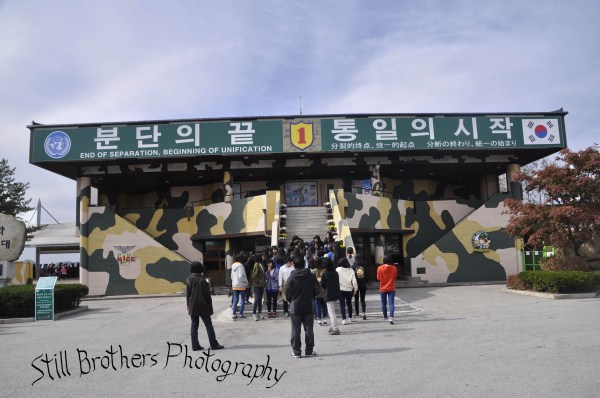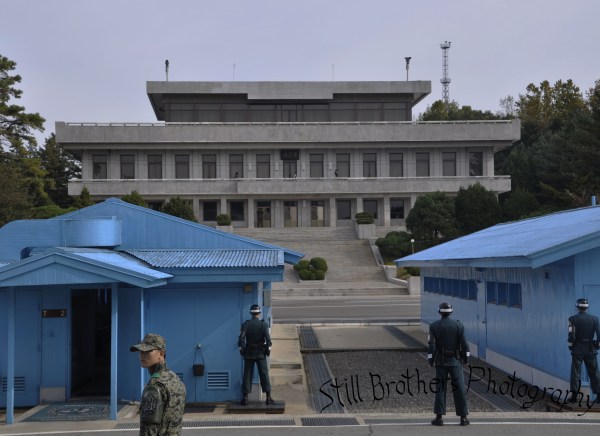Saturday Ben and I woke up bright and early to get to a bus near Samgakji station. He signed us up for an all day Demilitarized Zone (DMZ) tour out of the US base in Yongsan. Technically North & South Korea signed an armistice not a peace treaty so the war never officially ended. In 2011 Kim Jong Un took over as supreme ruler of North Korea and in 2013 he ended that armistice; there hasn’t been any direct military action but it certainly raised tensions.
Our tour guide, Jon Kim, was a native Korean who spoke English with a thick accent. He counted all 42 of us and checked to make sure we had proper id or passport. (You need either a military ID or a passport to get into the DMZ). After a few roll calls he finally had everyone and we were off. Just over an hour ride before we would arrive at Camp Bonifas and make our way into the Demilitarized Zone.
I decided to take a nap since we were up early on a Saturday. I slept fitfully waking up to random facts about the landscape like how the highway following the Han River has barbed wire and regular guard posts in case any communist commandos try to sneak in. He told us a little about his own life and how the many apartment buildings we were passing were largely family apartments now on the market due to empty nesters’ need to downsize.
Before long we were pulling in; I snapped off two shots from inside the bus before Specialist Mitchell came onboard to let us know the only building we could take pictures of was the visitor’s center. I hope a stop sign and water tower aren’t breaking too many rules!
We emptied the bus and had a bathroom break before signing a waiver indicating that we were in fact entering a warzone. The tour included “the entrance into a hostile area and the possibility of injury or death as a direct result of enemy action.” I’m writing post this so I guess that means I made it out safely?
We donned a UNSCA guest badge and sat through a brief presentation about the Korean War, the establishment of a military demarcation line or (DML) which roughly follows the infamous 38th parallel. Both North and South Korea were required to pull all personal and military equipment a minimum of 2 kilometers away from the DML making a 4 kilometer wide Demilitarized Zone which inadvertently has developed into a pristine ecosystem that naturalists hope to one day preserve as a national park. It’d be great if not for the live mines that keep the deer from living happily ever after.

Specialist MItchell’s presentation went through the progression from Kim il-sung to Kim Jong-il to Kim Jong-un and subsequent encounters in the Joint Security Area (JSA). He let us know we would be visiting the JSA and go into the building where North and South Koreans meet for negotiations and quickly ended the slideshow. We boarded a new bus, now with a military driver and were off.
We drove past a few checkpoints and Specialist Mitchell reminded us that unless he says we can take pictures we explicitly CANNOT take pictures. He pointed out many of the defenses that are in place; including an anti tank wall which had C4 visible beneath massive cement pillars, an electrified barbed-wire fence and a live minefield. Anytime a mine goes off they send a team to investigate what caused the explosion, 9 times out of ten they just end up cleaning up deer guts.
We passed Tae Sung Dong, a South Korean village which is heavily subsidized by the government. Residents each get about 17 acres to farm and can make a US equivalent of over $80,000 a year! Unufortunately the town’s population has be declining as a result of its proximity to North Korea and all of the youth’s moving out at first opportunity. In Tae Sung Dong stood a massive flag pole with the South Korean flag; it was built to rival the flag pole at Kijong-dong.
Kijong-dong is a village built with a massive flag and loudspeakers just past the border into North Korea. North Korea insists it is a populated farming village but the South and US military personnel have only seen soldiers come in and out to raise the flag. All evidence points to the village being completely uninhabited; combine that with the hours of propaganda blasted from the speakers and the village was aptly nicknamed “Propaganda Village.”
Here’s a fun fact! The day after Tae Sung Dong’s flag was raised the North built an even larger pole and flag which takes as many as 30 soldiers to raise & lower. Oh yeah, and its too heavy to leave out in inclement weather so all of the democratic security forces get a little laugh out of Kijong-dong.
Before long we arrived at the JSA and were told a few rules.
1) NO pictures except when and of what we are explicitly told is allowed.
2) Do NOT communicate in any way with the North Koreans, verbally, hand motions, eye contact, etc.
3) form 2 lines and stay in the lines.
4) NO dramatic movements
It felt a little like being back at camp with the hard-ass camp counselor but here it wasn’t a laughing manner. We all exited the bus and formed two lines before entering the Freedom House. Inside we climbed a staircase and were met with ROK (Republic of Korea) guards. They escorted our two lines out to the only view we could take photos of.
Upon exiting the Freedom House you can immediately see North Korea’s Panmun-Gak Pavilion and the buildings that are built on both sides of the DML. We found more ROK guards standing like stone statues and across the way a North Korean guard took out a pair of binoculars to stare us down.
The whole experience was a little cool, a little strange and rather enlightening. You hear about how crazy North Korea is and how they impose all sorts of radical rules and brainwash their citizens but here its the real deal. Mitchell told us stories about the “axe murder incident” and the Soviet Defector,Vasily Matusak, who was part of a North Korean tour when he suddenly sprinted across the border. North Koreans chased him with a primary goal of killing the Russian which sparked a 21 minute gunfight that left one South Korean and three North Koreans dead.
All Vasily wanted was a chance at freedom; in the end the South Koreans were willing to defend his right to have freedom once he crossed and risked their lives that day in 1984. The ROK guards were risking their lives today to make sure we were safe; although tensions at the border have been calm the past few months they are always on the look out for suspicious activity.

Here’s a fun fact! All the ROK guards must be at least 6 feet tall and black belts in taekwondo. It came in handy when 3 North Koreans tried to kidnap one of the guards who was locking a door. He single-handedly beat the crap out of all three before returning and being the poster-child for the new rule that states whomever is locking the door will be “held onto at the belt buckle by a fellow ROK soldier.”
After being told about some of the favorite hand gestures of the North Koreans who hang out in some of the blue buildings we were led into the one which hosts cross country meetings. Inside we found a table a flag and more ROK guards. It looked like a pretty plain room but it happens to be one of the most important locations in modern history. Crossing the “microphone line” brought me a few feet into North Korea. Didn’t get a visa stamp for this border crossing.
We spent a few moments taking pictures before heading back into our orderly lines and to the bus for a quick stop at the gift shop. I almost bought a bottle of North Korean wine or whiskey but I made the mistake of asking how it tasted. After a vigorous head shake and “Aniyo (NO!)” I decided to pass on the opportunity.
We left the JSA andheaded to the Third Tunnel. So far there have been 4 tunnels discovered underneath the DMZ heading towards Seoul. The most recent tunnel was discovered in 1990 and the first was found in 1974. Our visit into the third tunnel required all cameras to be stowed in a locker before donning a helmet and heading down a long ramp. South Korea found this tunnel in 1978 by filling small boreholes with water. When one of them sprouted into the air they immediately drilled more nearby and eventually found North Korea’s Third Aggression tunnel. Each tunnel can supposedly send a full infantry division, or roughly 20,000 soldiers each hour so they are very tightly monitored.
We descended at a steep incline for a few hundred meters before leveling out at the actual tunnel. It was like most other tunnels I’ve been in except with absurdly low ceilings. There was a faint black layer of coal that remained on some of the tunnel walls because when it was discovered the North tried to cover it up as an “abandoned coal mine.” There are zero coal deposits in the area, I’ve got a better dumb idea. A few hundred meters later we found barbed wire and a cement wall with a tiny window to peer into North Korea’s half of the tunnel. Their side was flooded but otherwise looked nearly identical to ours so we headed back.
We left the tunnel to head to a lookout with a wonderful view but yet another photo restriction. This one was even stranger; there were tons of binoculars set up for ₩500 ($.50) and a thick yellow line declaring “no photos past this point.” I tried to find a lighter companion to prop on my shoulders but with the patrolling ROK guard we decided that wasn’t a good idea and just held our cameras over our heads and hoped for a good shot.

The view gave some perspective about how close Taesungdong and Kijong-dong were to each other; their flags waved high above the rest of the scene. Ben and I snapped away while some of our new friends opted for the binoculars. They found the view to be the same but that they saw a moving bus proving whatever village they were looking at was actually inhabited. A few minutes later we were ushered back to the bus for a quick lunch stop outside of a ginseng festival before heading.

Today was a success. The DMZ and JSA certainly are unique places on Earth and worth the stop if you have the time. They aren’t exactly scenic and may not last forever if the South Korean dream that was reiterated on monuments with slogans like “end of separation, beginning of unification”comes true.













3 comments
[…] Remnants of the Korean War at the DMZ […]
[…] Remnants of the Korean War at the DMZ […]
[…] Remnants of the Korean War at the DMZ […]